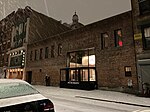Dimes Square is a so-called "microneighborhood" of New York City, located between the Chinatown and Lower East Side neighborhoods of Manhattan. The exact perimeter and nature of the neighborhood is debated, though survey data from The New York Times lists it as roughly the five blocks on either side of Canal Street between Allen Street and Essex Street.
The neighborhood's name, a play on "Times Square", refers to Dimes, a restaurant located at the intersection of Canal Street and Division Street on the Lower East Side. According to Marisa Meltzer of The New York Times, the nickname has transitioned from a term used "jokingly" to one used "semi-seriously".
The term Dimes Square has become a metonym for a number of associated reactionary aesthetic movements centered in the area. Media associated with the area include the podcast Red Scare, pirate radio station Montez Press Radio, and defunct print newspaper The Drunken Canal. An online Dimes zine named Byline was established in 2023 by Gutes Guterman and Megan O'Sullivan.
Ben Smith cited the neighborhood's emergence as a lockdown-flouting cultural hub during the COVID-19 pandemic in a 2021 New York Times piece. As the Covid-19 restrictions receded and the neighborhood became more mainstream, the associated transgressive art movement digitized and became increasingly prominent in online culture. In 2022, Julia Yost, an editor at First Things, a conservative religious journal, argued in an op-ed in The New York Times that the neighborhood and associated podcasters such as Dasha Nekrasova of Red Scare are the center of a post-ironic revival of traditionalist Catholicism.
The American indie-pop band Bleachers reference Dimes Square in their 2024 song "Jesus is Dead" from their self-titled album Bleachers.
In 2020, two blocks of Canal Street were closed off for an Open Streets permit, resulting in what Hannah Goldfield of The New Yorker describes as a "circus", "every night a music festival in the piazza."







